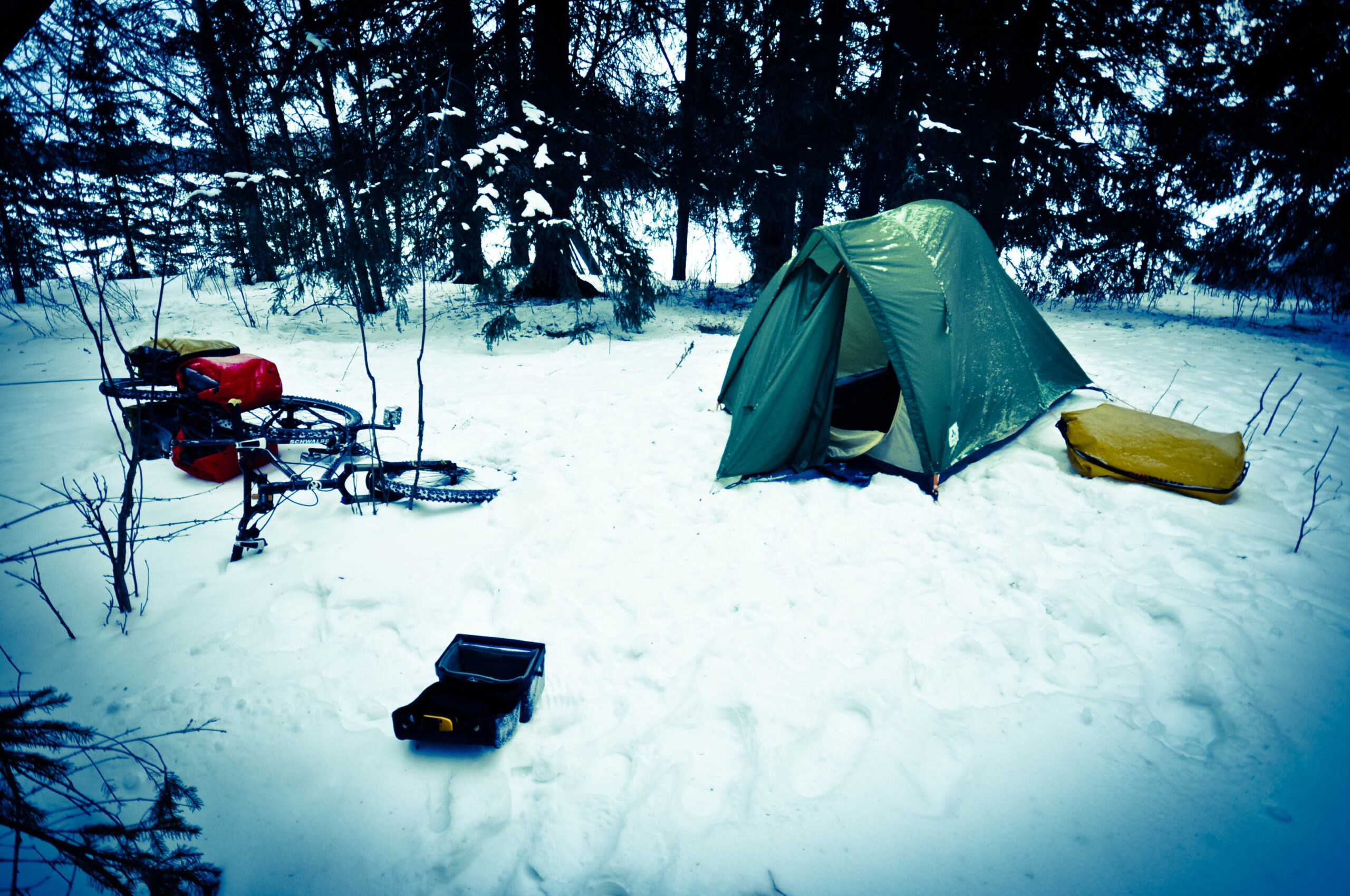It snowed/sleeted briefly yesterday morning, and that might well be the only snow we get this year; therefore I feel justified in publishing this post on techniques to stay warm when camping when it’s absolutely bloody freezing.
Follow the tips below, and you too can expect to get at least two or three hours’ sleep per night on an ill-advised last-minute bicycle journey to the Arctic Circle in the middle of winter with totally inappropriate equipment…
* * *
1. Know Your Gear (Or Take More Of It)
If you’re trying to minimise your baggage for winter camping, the key is becoming extremely familiar with how your gear performs in a range of conditions and temperatures.
But if you’re not sure how your existing equipment is going to work out, the safest strategy is to add more of it. Double up your sleeping bag, putting one inside the other. Stick a foam roll-mat or two underneath your inflatable mattress. Then, as you start to understand what works and what doesn’t, you can refine your gear selection to match the conditions.
2. Know Your Body (Or Play It Safe)
Some people sleep warm. Other sleep cold. Fitness, experience, age, gender, amount of body fat and other factors all contribute to the range of comfort levels experienced by different people using exactly the same gear. If you aren’t used to winter camping and don’t yet know where you fit into this, the same advice goes: bring extra gear and refine your kit list as you gain experience. It’s better to have brought along too many layers than not enough.
3. Wear The Right Kind Of Clothes
That cotton T‑shirt you wear at night while summer camping? It’ll ruin you in winter. Wear baselayers made of an appropriate material such as merino wool, bamboo, or insulating synthetics, with a close-fitting mid-layer on top. Add a woollen or fleece hat and neckwarmer. Pack a pair of thick woollen socks specifically for sleeping in and make sure you keep them dry. Only wear thick insulating layers if there’s enough space inside your sleeping bag without compressing the filling and inadvertently reducing its performance.
4. Go To Bed Warm
In winter, warmth originates from within, and any insulation from a sleeping bag or clothing is merely concerned with keeping it there. It’s pointless bedding down if you’re already freezing, so get warm by doing star-jumps before going to bed or performing sit-ups or press-ups in your sleeping bag.
5. Eat Late
The body needs fuel to generate heat, so eat a hot meal immediately before sleeping, and make the meal a fatty one, as fat is metabolised more slowly than carbohydrate and will last for longer as you sleep. Take extra rations of cheese or olive oil. (Cheese has the added bonus of giving you really vivid dreams.)
6. Get The Most Out Of Your Sleeping Bag
The insulating layer in sleeping bags functions by trapping air, so achieve maximum ‘loft’ by shaking air into a sleeping bag before bedtime. With down sleeping bags, do this with the bag upside down so the filling is encouraged to accumulate in the upper sections of the bag where the insulation is most needed. As mentioned in point 3, make sure that the bulk of any extra clothes isn’t having the effect of compressing the bag’s filling; performance might be improved by actually removing the thicker layers. Avoid using down bags inside narrow bivvy bags for exactly the same reason — better draping the bivvy bag on top.
7. Add More Layers Outside
Get one of those thin metallic survival blankets and drape it over the torso area of your sleeping bag. If you don’t have one, do the same with your waterproof jacket or anything else that would add another layer on top of you without squashing the air out of your sleeping bag’s insulating layer.
8. Keep Your Sleeping Gear Dry
Protect down sleeping bags from getting wet at all costs, as this will reduce their insulating effect to near zero. Avoid breathing into the sleeping bag while sleeping, no matter how tempting, as it introduces moisture from within which will then condense in the insulating layer. For the same reason, squash all the air out of your bag as soon as you get up in order to expel body moisture, and dry out your bag fastidiously on a daily basis whenever you get the chance.
Winter camping can be utterly miserable. I began that journey north from Oslo getting everything wrong. I ended up damp and shivering at around zero degrees in a very expensive mountaineering sleeping bag supposedly rated for comfort at ‑25°C. The first week of that journey was one of the most miserable weeks of my life.
Yet winter camping can also be one of the most beautiful and memorable experiences of all, made all the better by having learned how to survive outside in such conditions. By the time I reached Swedish Lapland a month later — where the temperatures at night were usually approaching ‑30°C — I was able to pass the night in comfort in my spare sleeping bag — a cheap Chinese knock-off I’d bought in Tehran one time and which contained less than half the amount of filling.
And if there’s a message to be had from this, it’s probably that it’s better to leave before you’re ready than not to leave at all. You’ll figure the rest out on the road.
Any more tips for successful winter camping? Please do share them in the comments section for future reference.










Something to add?